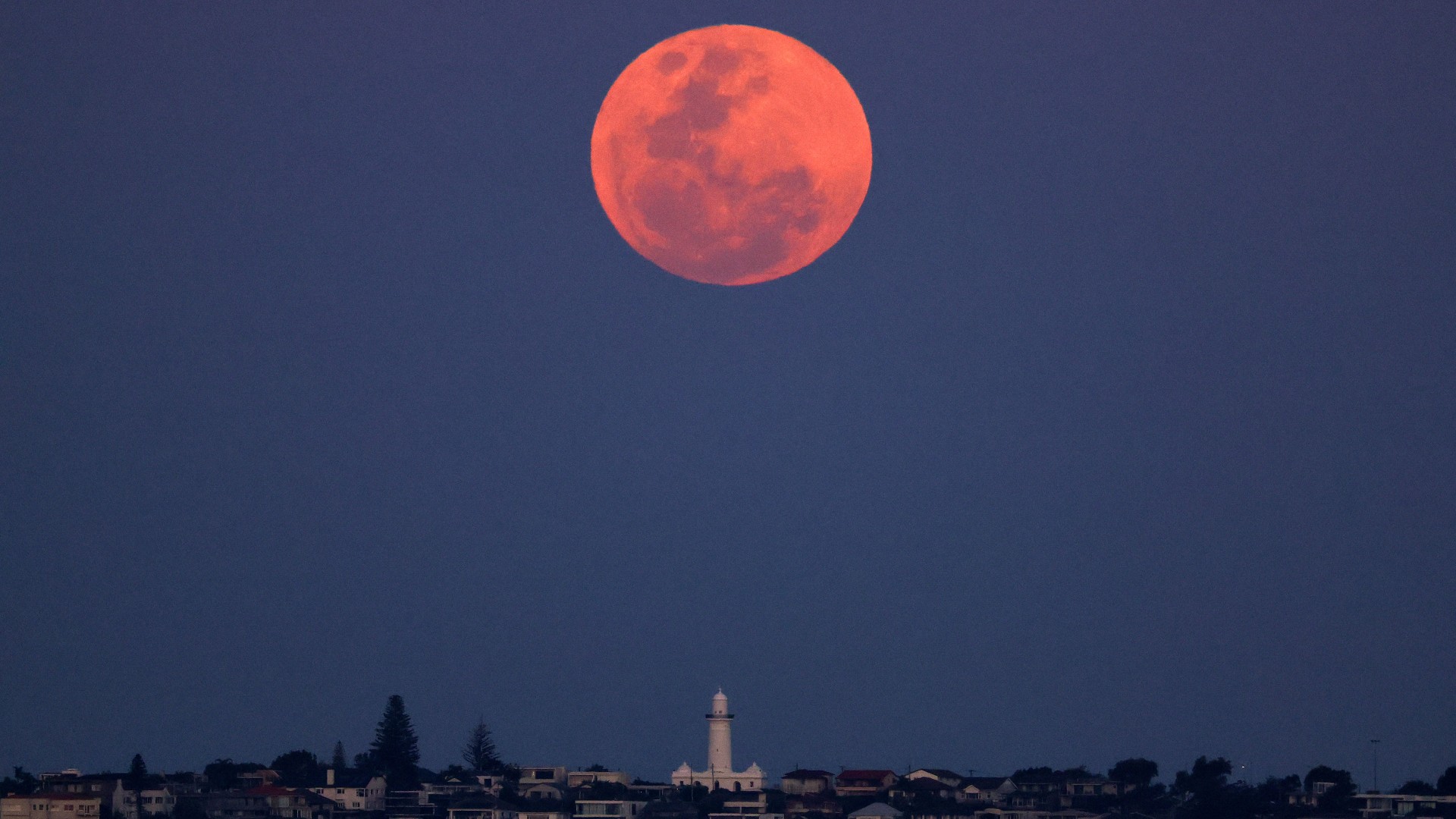Last supermoon of 2023 rises tonight. Don't miss the Harvest Moon shine with 3 bright planets
Rising on Friday, Sept. 29, the Harvest Moon will be joined in the sky by our solar system's two largest planets, Jupiter and Saturn, and its smallest, Mercury.

September's full moon, known as the Harvest Moon, will rise tonight (Sept. 29) — and it is a special one. Not only will it be the fourth successive supermoon of 2023, but it is also the final supermoon of the year, thus marking the end of a very supermoon summer.
Fittingly for such a special supermoon, the Harvest Moon will also be joined by a parade of planets in the sky, including the solar system’s largest worlds, Jupiter and Saturn, as well as its smallest, Mercury.
From New York City, the fully illuminated moon will rise at around 18:33 EDT (2233 GMT) and set the following day at around 06:52 EDT (1052 GMT), according to In the Sky. Following the full moon, which will be located in the Pisces constellation, the lunar face will recede, a process astronomers call "waning." After that, Earth's natural satellite will head toward its next intriguing phase, turning into a completely dark new moon on Oct. 14, which will mark the start of a new 29.5-day lunar cycle.
The run of four consecutive supermoons began with the Full Buck Moon on July 3. This was followed by two supermoons in August, the Full Sturgeon Moon on Tuesday, Aug. 1, and the Full Blue Moon on Aug. 30..
Related: Night sky, September 2023: What you can see tonight [maps]

Looking for a telescope to see the full Harvest Moon? We recommend the Celestron Astro Fi 102as the top pick in our best beginner's telescope guide.
The term "supermoon" refers to full moons that happen around the time when the moon is closest to Earth in its orbit, an approach called perigee. This happens because the moon’s orbit around Earth is an ellipse rather than a perfect circle, meaning there are times when it falls further away from our planet and times when it comes closer.
The proximity of the moon during supermoons means the lunar disk can appear around 30% brighter and around 14% larger as seen from Earth compared to the appearance of the lunar face during "regular" full moons. These differences may be visible to moon-watchers with a lot of experience observing lunar events, but aren’t really that noticeable with the unaided eye to skywatchers who don’t often scrutinize the moon.
Breaking space news, the latest updates on rocket launches, skywatching events and more!
The moon will reach perigee in the evening of Wednesday, Sept. 27, at around 21:06 EDT (0106 GMT), two days before the Harvest Moon, according to NASA. By the time the moon’s fully illuminated face is turned toward Earth, it will be around 224,657 miles (361,552 kilometers) from our planet, according to eclipse expert and retired NASA astrophysicist Fred Espanak. This is opposed to the moon's average distance from Earth, which falls around 238,000 miles (382,900 km).
However, this won't be the closest or, therefore, brightest supermoon of 2023. During the Aug. 30 Full Blue Moon, the moon was around 222,043 miles (357,343 km) from Earth, according to Espanak.
The first planet to visit the final supermoon of 2023 on Saturday will be Saturn, the second-largest planet in the solar system, which will rise at around 17:18 EDT (2118 GMT) and will sit in the Aquarius constellation, according to In the Sky. Saturn’s fellow gas giant and the solar system’s largest planet, Jupiter, will rise at 20:17 EDT (0017 GMT). Jupiter will sit to the left of the Harvest Moon in the Aries constellation.
Mercury will be the last planet to pay the Harvest Moon a visit and will be the toughest to spot. The closest planet to the sun, Mercury is currently at its furthest from our host star. Though it appears in the morning sky, it disappears in the evening. On Saturday, the solar system’s smallest planet will rise at around 05:30 (0930 GMT). Mercury will share the sky with the full moon for just over an hour before the final supermoon of the year sets.
Skywatchers who miss the Harvest Moon will have to wait a while for the next supermoon, which will also be a Harvest Moon, rising on Sept. 18, 2024. This will be the first of two supermoons next year, with the second occurring a month later on Oct. 17, 2024.
If you are hoping to catch a look at the Harvest Moon, our guides to the best telescopes and binoculars are a great place to start.
If you’re looking to snap photos of the night sky in general, check out our guide on how to photograph meteor showers, as well as our best cameras for astrophotography and best lenses for astrophotography.
Editor's Note: If you snap an image of the Harvest Moon and would like to share it with Space.com’s readers, send your photo(s), comments, and your name and location to spacephotos@space.com.

Robert Lea is a science journalist in the U.K. whose articles have been published in Physics World, New Scientist, Astronomy Magazine, All About Space, Newsweek and ZME Science. He also writes about science communication for Elsevier and the European Journal of Physics. Rob holds a bachelor of science degree in physics and astronomy from the U.K.’s Open University. Follow him on Twitter @sciencef1rst.

